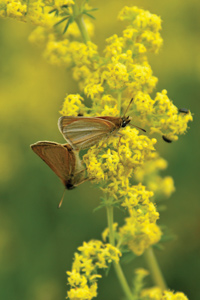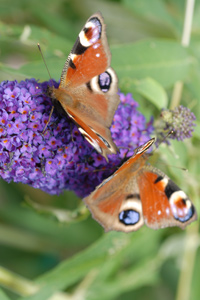
Butterflies
A lovely sight in the spring and summer months, butterflies and moths are part of our natural heritage and indicators of a healthy environment and ecosystem. Not only are they beautiful and diverse, butterflies and caterpillars are an important part of the food chain, supporting birds, bats and other insectivorous animals.
For a list of nectar-rich plants that attract butterflies take a look at our 'Plants for wildlife' guide. For guidance on native plants for butterflies and other wildlife take a look at our 'Native v non-native plants' guide.
Do your bit to save butterflies
There are 58 species of butterfly native to the UK and many of these are under threat of extinction. Recent reports have shown, however, that conservation efforts have given some of our most threatened species a boost, including Heath Fritillary, Marsh Fritillary, Large Blue and Silver-Studded Blue. Habitats are being improved and restored and this has had a positive effect on these species. You can do your bit to help these fragile insects, by planting nectar-rich flowers for butterflies and moths in your garden.
Butterfly plants
Plant some suitable nectar plants for butterflies and they will visit your garden, however small it is. Some of the best butterfly plants for summer nectar include Buddleja, Verbena bonariensis, Lavender, Wallflowers and Oregano (Marjoram). Moths will feed on the same plants as butterflies but are particularly drawn to night-scented plants such as Jasmine, Honeysuckle, Evening primrose and Night-scented stock.

If youre looking to create a container garden for butterflies there are many smaller nectar plants which are suitable for growing in containers and window boxes. Herbs left to flower such as Thyme, Oregano, Lavender and Mint are excellent plants to try, along with dwarf Buddleja, Alyssum, Wallflowers, Allium, Hebe, Heliotrope and dwarf Verbena bonariensis. Here are some top tips when growing plants for butterflies:
- • Plant the same types of nectar plants in blocks in sunny, sheltered spots.
- • Dead-head regularly and water your plants well to keep them healthy so they will produce more nectar for the butterflies.
- • Most importantly, don't use pesticides or insecticides, as these kill butterflies and many other beneficial insects too.
Caterpillar host plants
The commonly suggested nectar plants for butterflies and moths are often unsuitable as egg laying sites. However, providing nectar in the garden is still a very important stepping stone between nature reserves and other natural habitats where butterflies breed. To try and encourage butterflies to breed in your garden grow areas of stinging nettles, thistles, garlic mustard, ladys smock, holly, ivy, alder buckthorn, birdsfoot trefoil or docks. Creating a wildflower meadow may also encourage breeding. Learn more about how to sow wildflower seeds here.
It is worth noting that caterpillars tend to have a narrow range of native host plants and many butterflies need specific habitats in which to breed, which often cant be created at home. Some butterflies wont readily colonise new sites, requiring an existing butterfly colony to be present very close by.
Big Butterfly Count
The Big Butterfly Count is a nationwide survey that provides valuable information on numbers and allows the Butterfly Conservation charity to plan how to protect butterflies in their natural habitats. Launched in 2010 it has rapidly become the worlds biggest survey of butterflies. Just spend 15 minutes in a sunny spot, either in your garden, a park, woods, or fields and record how many of each species you see. Butterfly Conservation has a chart to download to make it easier for you! The survey website can be accessed at www.bigbutterflycount.org. This is a great way to get children involved in gardening and conservation.
Quick Links:

Wildflowers such as Lady's Bedstraw are rich in nectar, and patches of wild plants may encourage butterflies to breed. Find out more about how to sow wildflower seeds here.
Sign Up For Exclusive Special Offers




© 2025 Thompson & Morgan. All rights reserved. A division of Branded Garden Products Limited.




